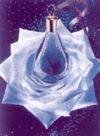Past Perfect : Return to Retro Glamour
In the July column of the Financial Times Magazine, I talk about the reissued perfume classics we’ve been seeing lately–Balmain Ivoire, Molinard Habanita, and Jacomo Silences, among others. Titled Past Perfect, the article is my recap of the latest “retro glamour” trend. There are many unromantic reasons why it’s tempting for perfume companies to reintroduce classics (for instance, having the rights to an existing brand), but perhaps we’re really craving more glamour. I certainly do!
“There is a distinctive retro vibe in the air these days. Strolling through the aisles of a local perfume boutique, I suddenly noticed something that I hadn’t seen for years — Ivoire de Balmain. The bottle, a heavy glass square filled with peach-tinted liquid, was different from the original all-white flacon of this 1979 classic, but the perfume itself was recognisably Ivoire. It smelled of clean skin scrubbed with jasmine soap, crushed green buds and a whisper of earthy patchouli. It was softer and sweeter than I remembered it, but I liked its glamorous aura. To read the rest, please click here.”
If I had one perfume wish, it would be for Jean Patou to reissue Vacances as close to the original as possible. It was an exquisite blend of lilac, rose and green sap. I also would have liked for Guerlain Après l’Ondée, my favorite classic, to become available in the parfum form, but that’s already crossing into the realm of fantasy.
What is your favorite classical perfume? What perfume wishes do you have?
Bolshoi Ballet School, Moscow, 1958, photography by Cornell Capa via 0rchid-thief.livejournal.com.















Joi in Giorgio Armani Mania : Long Lost Favorite Perfume: Yes!! January 25, 2024 at 2:54am